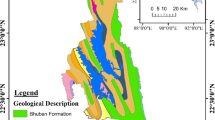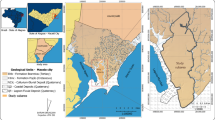Abstract
The state of Santa Catarina, Brazil, has climatic, biological, geomorphological and geological characteristics that contribute directly to the occurrence of landslides. From the geological point of view, colluvial materials resulting from landsliding deposited in the lower parts of the slopes are denominated as hillslope deposits although they do not necessarily originate from the same rock. This study evaluated the geotechnical parameters of the slopes at Blumenau, where intense rainfalls and potentially unstable soils are present on steep hillsides and give rise to unstable colluvial slopes below. These factors resulted in a large number of slopes covered by colluvial deposits. However, in geotechnical mapping these kinds of materials are treated as “hillslope deposits” units with similar behaviors even though they have different geological-geotechnical evolutions and have experienced distinct processes of pedogenesis. The paper covers the classification as colluvial soils and landslides, as well as the use of geotechnical laboratoratory tests and geotechnical mapping. Evaluation of the geotechnical behavior of the soils was based on geotechnical characterization tests and drained direct shear tests in which parameters of cohesion and internal friction angle were obtained. Thus, the goal of this study was to understand the variability of the geotechnical parameters of these colluvial soils that formed as “hillslope deposits” units according to Davison Dias (1995) methodology, so that they could be classified based on their lithotypes. The study results will help in urban planning in Blumenau and contribute to safety and predictability of areas subject to possible landslides.
Access provided by Autonomous University of Puebla. Download conference paper PDF
Similar content being viewed by others
Keyword
1 Introduction
Natural disasters related to landslides are important processes to geomorphological and dynamic evolution of hillsides. In urban areas, besides gravity, it is possible to cite the anthropic activities (bad management of water resources, unplanned landfills, poorly executed slope cuts or vegetation cover removal) as factors for the occurrence of landslides. In Brazil, landslide is related to intense rainy seasons, which results in national disasters when it happens in big Brazilian cities (de Castro 2003).
The development of Geotechnical engineering in Santa Catarina state, southern Brazil, has been constant. In 2008, the region known as Itajai Valley was affected by several landslides and the socioeconomic impacts were significant, causing civil and governmental interest on the subject. In total, 60 cities and 1.5 million people were affected by landslides and floods. However, due to disorderly urban planning many occupations are in sites with a higher incidence of landslides.
Blumenau, situated in Itajai Valley and this paper’s study area, is highly susceptible to the occurrence of landslides, where factors include high rainfall weak soils and hill-sides. These factors resulted in the presence of slopes filled by colluvial deposits that may be directly associated to colluvial deposits occurrence.
In subtropical climate regions, the intense and prolonged rain results in the development of residual soil profiles of great thickness and provides enough material to the remobilization and, consequently, colluvial deposits formation on the hillsides (Vitte 2005). The residuals soils are consequence of the weathering from their places of origin. Soil with small particles are found in soil surface and the grain size increases according to the analyzed depth (Das 2011). According to Lacerda and Sandroni (1985), colluvium is “a deposit consisting of blocks and/or grains of any diameters, carried by gravity and accumulated at the foot or in a short distance from slopes or rocky cliffs”. Two processes work like a trigger to colluvium, and both are related to intense and prolonged rainy seasons. The first one is the accumulation of soil in lower regions as result of slipping. The second is the movement of residual soil on the hillside itself. In this last case, the deposit can be found as disaggregated (Lacerda 2002).
This study was done following the methodology of geotechnical mapping proposed by Davison Dias (1995), one of the most applied methodologies in Brazil. However, in this methodology, the colluvial deposits are treated as if they all had the same behavior, although they have different geological-geotechnical evolutions and have been submitted to distinct processes of pedogenesis. Therefore, the main objective of this paper was to evaluate the geotechnical parameters of colluvial soils of the different lithologies and define whether lithology should be a factor in the Davison Dias’ classification of colluvial deposits.
2 Description of Study Area
Blumenau is located in Santa Catarina state, southern Brazil, and occupies an area of 519.837,000 m2, where approximately 40% represents urban area. The city is 150,000 km away from the state capital, Florianopolis. This region is characterized by occurrence of natural disasters such as landslides and floods, especially in rainy seasons.
The combination of the intertropical and polar air masses has direct influence in the state’s climate, which is defined as subtropical. In Köppen’s climate classification, the most widely used in the world, Blumenau is characterized for being a city of humid mesothermal climate with well-distributed rains and hot summer.
There are four geological units in Blumenau’s area: the Santa Catarina Granulite Complex, Brusque Metamorphic Complex, Itajaí Basin and Quaternary Deposits. Blumenau’s relief is characterized by the presence of steep mountains which represent the main units (SCGC, BMC and IB) of the city. The alluvial deposits correspond to the central portion of the city and are cut by the Itajaí-Açu River.
3 Methodology
The pre-fieldwork activity follows the methodology of geotechnical mapping proposed by Davison Dias (1995). In which the geological and pedological maps are overlapped. Thus, a new geotechnical map is created and from this map, via aerial images, the sampling points are chosen for each geotechnical unit delimited.
Disturbed and undisturbed samples of 8 different lithologies were taken from 13 locations (Fig. 1) in both colluvial and residual soils. Disturbed samples were subjected to geotechnical characterization tests, whereas the undisturbed samples, which were taken in metal molds (Fig. 2), were subjected to direct shear tests. The sampling points are shown in Table 1.
Characterization tests follows the Brazilian Association of Technical Standards. The soil’s physical properties analysis and grain size analysis were performed to characterize the materials. The physical characterization test of the soil measured its water content, solid specific weight, void ratio, porosity and degree of saturation. The grain size test performed adopted the NBR 6502/95 standard. According to which the grain size distribution can be divided into gravel (>2.0 mm), coarse sand (2.0–0.6 mm), medium sand (0.6–0.2 mm), fine sand (0.2–0.06 mm), silt (0.06–0.002 mm) and clay (0.002–0 mm).
Metal molds that measure 104.04 cm2 and 0.2 cm in height were used for the direct shear tests, both in drained and natural humidity conditions, under normal stresses of 33, 78 and 128 kPa. The shear speed was 0.307 mm/min. In each soil it was possible to define the Mohr-Coulomb envelope, as well as the internal friction angle and cohesion.
5 Results and Discussions
This chapter presents the results and discussions about the geotechnical characterization and direct shear test.
5.1 Geotechnical Characterization and Grain Size Analysis
The geotechnical characterization results and grain size analysis data are presented in Tables 3 and 4. The characterization defined soil physical characteristics as solid specific weight (γs), water content (w), void ratio (e), porosity (n) and degree of saturation (Sw).
In colluvial soils (B1, B2 and B3), the variation in grain size was expected due to the heterogeneous of grain sizes, according to Lacerda and Sandroni (1985). The grain size distribution in colluvial soils presented a high silt and clay content, ranging from 54.63 to 67.18%. In addition, the sand content ranged from 29.94 to 38.93%.
In residual soils it is necessary to highlight the amount of gravel at point B9. This may be related to the sampling depth, close to the bedrock.
5.2 Direct Shear Test
To define the Mohr-Coulomb envelope at least three tests were necessary under normal stresses of 33, 78 and 128 kPa. Thus, it was possible to define the parameters of cohesion and internal friction angle.
The direct shear test results in inundated conditioning are shown in Table 5.
In colluvium materials, the lowest and highest cohesion value (5.9 and 19.4 kN/m2) were obtained in soils developed in mafic gneiss (B1) and fine-grained sandstone and siltite (B3), respectively. In the meantime, the lowest and highest angle of internal friction (21.0° and 30.7°) were obtained at points B3 and B1, respectively.
In residual soil the lowest cohesion value (8.1 kN/m2) was obtained in residual soil from mafic gneiss (B5). The highest (23.9 kN/m2) was obtained in residual soil from granite and migmatite (B9) (Figs. 3 and 4).
The residual soils are represented by squares and dashed lines in Figs. 5 and 6. While colluvial soils are represented by circles and solid lines. Equal colors represent colluvial and residual soil sampled at nearby points, as with points B1 and B4, for example.
6 Conclusions
When comparing the granulometric compositions and direct shear results of the colluvial soils and their respective residual soils, such as B1–B4, B2–B5 and B3–B12, no similar compositions or trends are found, whereas the behavior of the colluvial soils relates to the grain sizes presents.
For the colluvial materials the soil’s behavior is directly regulated by the granulometric composition. It is verified that the highest cohesions are associated with the finer materials (B2 and B3). Meanwhile, the course-grained material (B1) is the one with the highest effective internal friction angle.
Residual materials also tend to behave according to their granulometric compositions. However, points such as B5, B9 and B11 do not follow this trend and show discrepancy according to the granulometric criterion. The lithotypes of these materials are associated with metamorphic processes and sedimentary structures, which may have influenced cohesion and internal friction angle.
There are no trends related to shear strength parameters (c’ and ϕ), either between the colluvium and residual soils with same lithotype or among colluvial soils with different lithotypes. Thus, it is possible to conclude that colluvial deposits should be treated as independent geotechnical units in Davison Dias’ (1995) methodology.
References
de Castro, A.C.C.: Manual de Desastres, 1st edn. Ministério da Integração Nacional, Brasilia (2003)
Das, B.M.: Fundamentos de Engenharia Geotécnica, 7th edn. Cengage Learning, São Paulo (2011)
Davison Dias, R.: Proposta de metodologia de definição de carta geotécnica básica em regiões tropicais e subtropicais. Revista do Instituto Geológico, 51–55 (1995)
Lacerda, W.A., Sandroni, S.S.: Movimentos de Massa Coluviais. In: Conferência brasileira de estabilidade de encostas, 1–19. Clube da Engenharia, Rio de Janeiro (1985)
Lacerda, W.: Comportamento geotécnico de massas coluviais. In: Simpósio de Pratica de Engenharia Geotécnica da Região Sul, Joinville (2002)
Perazzolo, L.: Estudo geotécnico de dois taludes da Formação Serra Geral, RS. 2003
Vitte, A.C.: Relações entre a estratigrafia de rampas de colúvios e a evolução das vertentes na bacia do Ribeirão Juncal, município de Salto de Pirapora, SP. In: Anais do X encontro de geógrafos da América Latina, São Paulo (2005)
Author information
Authors and Affiliations
Corresponding author
Editor information
Editors and Affiliations
Rights and permissions
Copyright information
© 2019 Springer Nature Switzerland AG
About this paper
Cite this paper
Alves, L.E.C., Espindola, M., Müller, V.S., Broetto, M.Z., Pizzolo, R.L., Hickel, V.F. (2019). Evaluation of Geotechnical Parameters of Slopes at Blumenau, Santa Catarina, Brazil. In: Shakoor, A., Cato, K. (eds) IAEG/AEG Annual Meeting Proceedings, San Francisco, California, 2018 - Volume 2. Springer, Cham. https://doi.org/10.1007/978-3-319-93127-2_11
Download citation
DOI: https://doi.org/10.1007/978-3-319-93127-2_11
Published:
Publisher Name: Springer, Cham
Print ISBN: 978-3-319-93126-5
Online ISBN: 978-3-319-93127-2
eBook Packages: Earth and Environmental ScienceEarth and Environmental Science (R0)










